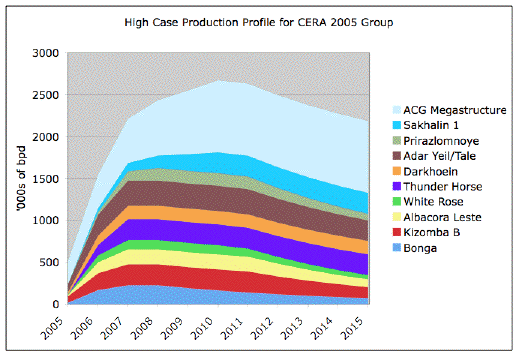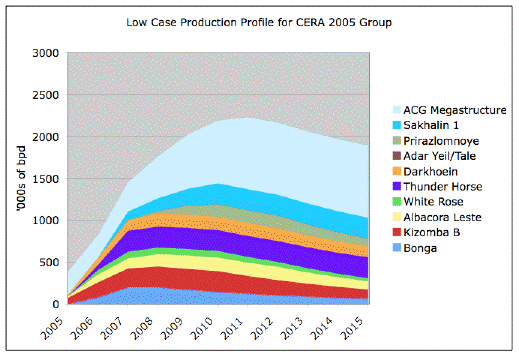Quick Update on CERA 2005 projects
Posted by Stuart Staniford on October 8, 2005 - 2:58am
I am slowly working on a bottom-up production model. As I trawl through endless oilfield development updates, I thought it might be useful to capture some of what I'm finding out in manageable chunks. So here's a quick status update on the projects that Heading Out documented from CERA's list for 2005.

- Bonga is delayed from September to November for first oil.
- Kizomba B came on in July, 6 months ahead of schedule.
- Albacora Leste, a year behind it's original schedule, is supposed to have started right around now, but I can't find confirmation of it's status.
- White Rose is on track to start any day, if it hasn't
- Thunder Horse is delayed into next year, due to the hurricane.
- Dharkoein in Iran, appears to have 50000 bpd as of July, and to be headed for 160000 bpd by December of next year.
- Adar Yeil/Tale was supposed to come on with first oil towards 200000 bpd this year and 300000 bpd by the end of next year. Looks like that's on track for about July first oil. However, it should be realized that this whole area of Sudan has been incredibly unstable, which is why this field, discovered in 1981, hasn't been developed before. The war reportedly began because the government wanted to clear all the local people away from the oilfields.
- Primorsk is a port, and HO was uncertain whether CERA meant Priobskoye (which ODAC lists for 2004) or Prirazlomnoye (ODAC has it for 2005). Priobskoye turns out to be a continuously producing field that Sibneft has been reworking. So I don't think it makes sense to count it as a new field. Prirazlomnoye is the first Barents Sea Arctic field. It is not going to happen in 2005 (they haven't towed the platform to the field yet), and is not looking too certain for 2006 either. This may be the most significant data point, because once we are done with the deep water, polar oil is about the only thing left to go get, so it's of considerable significance whether or not we can figure out how.
- Sakhalin I is producing oil, but the infrastructure to export that oil will not be ready until the first quarter of 2006. It will be ramping up production to reach 250000 bpd by the end of 2006. Gas is being exported already.
- The ACG Megastructure has been producing for a little while, with the Chirag early oil project running at about 140000 bpd, but the main bulk of the project started to come on line in Feb of this year, with phase I taking this year up to about 410,000 bpd for this year. Phase II will take that up to 800000 bpd, and it's expected to reach 1m bpd by 2010. We don't count the Chirag part that's been running since 1997 as a new project here.





Kizomba A
Shah Deniz
Sakhaliin II
Mad Dog
Holstein
Girassol
Buzzard
Clair
Snohvit
That's off the top of my head, late on a Friday. I'll update tommorrow.
http://www.transneft.ru/Projects/Default.asp?LANG=EN&ID=227
http://www.eia.doe.gov/emeu/cabs/choke.html
http://www.intertanko.com/tankernews/artikkel.asp?id=8362
During my trip to Russia in summer we drove from st. Petersburg to Vyborg via costline and stopped in Primorsk just to have a look at the terminal (which was of course my idea , others didnt care so much of the terminal which exports most of our crude oil we use in Finland). Well we didnt see so much just the facility and many tankers. Here in Finland increasing tanker traffic is in the news quite often. There is fear of possible tanker accident and what it might cause to ocean which is already one of the most polluted in the world. In winter time when gulf is frozen , tankers need occasionally icebraker to make the trip, sometimes they get stuck on the ice for weeks. Finland is trying to pressure Russia to require double-hulled tankers for oil transports.
http://www.cdi.org/russia/johnson/8236-12.cfm by Leslie Dienes.
From EnergyBulletin
http://www.energybulletin.net/9498.html
Sadad al Husseini sees peak in 2015
Steve Andrews, ASPO-USA
While al Husseini's comments about when peak oil might hit us are more optimistic than those of ASPO-Ireland and a host of others, they certainly strike a vastly more realistic chord than the typical fare from Saudi Aramco press releases and presentations. [see article for the rest]
over at mobjectivist(in the blogroll section)there is a pretty disturbing world cumulative production projection.
i was just wondering if someone at this site could provide some educated commentary on the graph and its assumptions. it seems there are a lot more commentators here than at mobjectivist.
i wont comment too much since there are others much more qualified to do so, but if that graph is right, it seems that we would be getting off lightly with a 30 year depression. or maybe this is wrong also, and the graph looks more severe than it really is?
You want the Global Economic Forum for the 7th October. If it's not visible click on the Archive link and select it from the calendar. The article you want is called 'Global: The Oil Debate Converges (Partly)'. I won't post the article as I don't know the copyright implications.
In your 2006 projects, you might want to add Mars but put it in as a negative wedge starting in September of 2005.
All this is just guessing. For me this seems to confirm the view that Russia and Saudi-Arabia will be decisive. They can unexpectedly show such a depeletion rate that those new projects cannot help.
Besides the even most optimistic forecast here doesn't spell much growth (under 2%) in the world production anyway. So we could reasonably expect rather flat production in the next few years.
I suppose it's somewhat valid to ask whether we believe the 2-2.5mbpd eventually coming from CERA's class of 05 is enough to offset type II depletion in the rest of the worlds existing fields in 05 - if they are, in aggregate, declining at more than 2 1/2% to 3%, then one could argue we are starting to go backwards. But this is tricky - some recent fields will still be growing, while older ones are declining. And I don't want to conclude that the small fields don't count significantly at present. Also, in a sense it's really the class of 02-04 that will be fully hitting their peaks around now and either offsetting this year's declines or not (it's the difference between accrual accounting and cashflow accounting for those who know some accounting - but I think cashflow - oilflow - is relevant here: we can't power our cars with future oil).
I was somewhat positively surprised by ACG. Looks like Azerbaijan is about to enter the positive column in this picture in a pretty big way:
Khazakstan is perking up quite nicely. I've been involved with a major artificial island project (for environmental reasons) to produce at minimum a billion barrel field.
But Iran is still causing problems. Their claim to Caspian acerage is far beyond reason. And international precedent. And negotiations between the major players are non-existent. It is holding up major production opportunities.
I saw the initial post you had on this topic. Are there others around (with other years)?
OPEC Reveals Global Light Sweet Crude Peaked.
I thought Sakhalin was gas - is your chart showing ng liquids?
So we passed peak sweet/light (PSW) some time ago.
APSO has revised to show PO delayed. Meanwhile they have a very detailed description of the increasingly heavy/sour production. Has anybody tried to calculate the overall effect on gasoline/kerosene production? Might overall liquids production increase, delaying PO, while product decreases, meaning we pass PG and PK? Maybe PD comes a bit later?